
Washington candidate filing week begins for the 2024 election
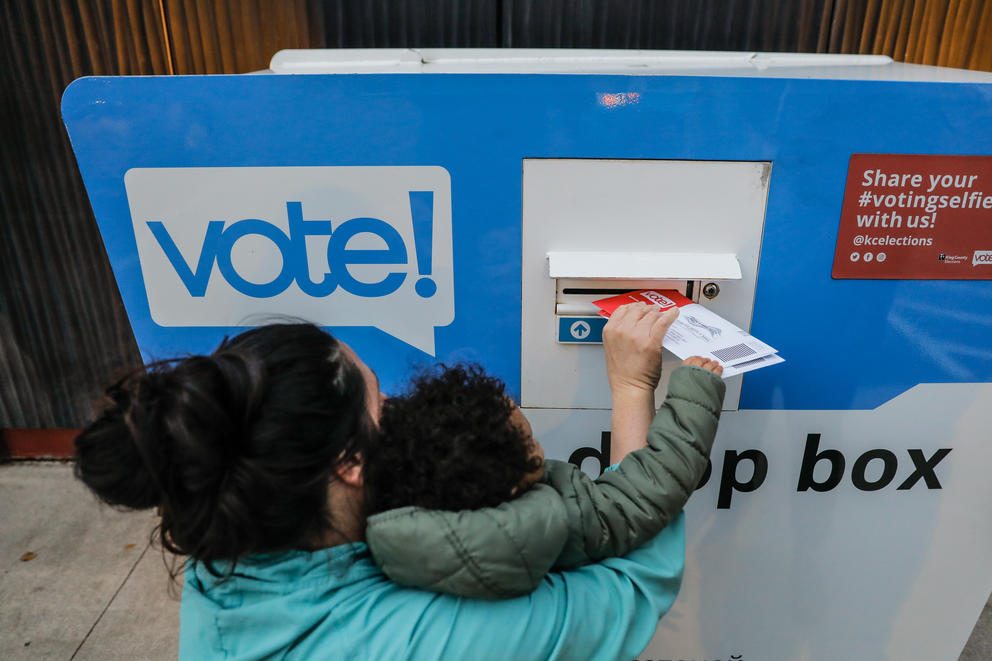
Voters drop off ballots at the White Center Library ballot box on voting day, Tuesday, Nov. 7, 2023. (Genna Martin/Cascade PBS)
Candidate filing week for races in the general election begins Monday, May 6. People interested in running for federal, statewide, Legislative and Superior Court and Court of Appeals positions can file for election with the Secretary of State’s office through Friday, May 10. People interested in running for local races can file with their local county elections offices.
Positions that attract more than two candidates will be on the Aug. 6 primary ballot. The top two vote-getters in each race will proceed to the general election on Nov. 5.
Statewide seats this year are governor, lieutenant governor, secretary of state, attorney general, superintendent of public instruction, treasurer, public lands commissioner and insurance commissioner. In the Legislature, all seats in the state House are up for election, as well as 25 seats in the state Senate. Federal races on the ballot this year are all 10 congressional seats and U.S. Sen. Maria Cantwell’s seat.
People interested in running for these positions can file with the Secretary of State’s Office online or in person in Olympia. The filing fees for each seat are 1% of the office’s annual salary. Filing period closes Friday 5 p.m. sharp, according to the state.
Races for local seats – for example, District Court positions and the special election for Seattle City Council Position 8, currently held by Councilmember Tanya Woo, who was appointed to a vacated seat this year – will be handled at local elections offices (in these examples, King County).
The deadline to withdraw oneself from candidacy is 5 p.m. Monday, May 13.
More students experiencing homelessness in Washington
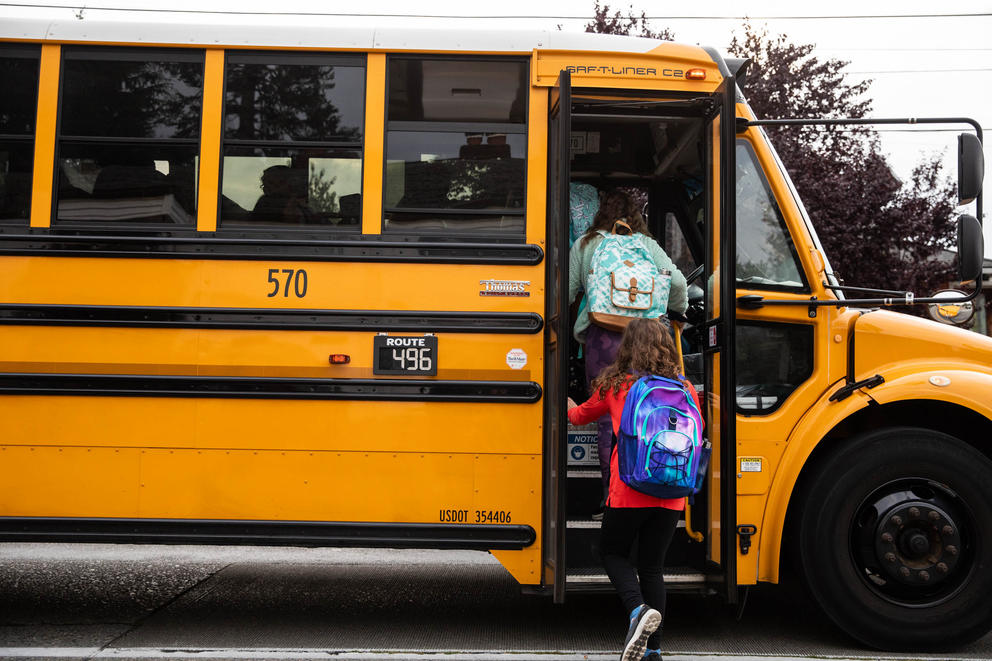
Students board the bus to Hamilton International Middle School on the first day of school on Wednesday, Sept. 14, 2022. (Amanda Snyder/Cascade PBS)
The number of students experiencing homelessness in Washington has grown by about 15% compared to the school year when the pandemic began, according to new data from the Office of the Superintendent of Public Instruction.
OSPI reports 42,436 students were homeless or had insecure housing during the 2022-23 school year compared to 36,996 during the 2019-2020 school year, while the total population of students enrolled in public school decreased during that time.
The every-other-year report to the Legislature explains that the number of homeless students reported in the past few school years may have decreased during the pandemic because school districts had difficulty identifying and serving those students.
The report breaks down the homeless student population by ethnicity, and notes that while 3.8% of all public school students statewide have experienced homelessness, the percentages are greater among Native Hawaii and Pacific Islander students (11.8%), Black or African American students (7.4%), Native American or Alaskan Native students (7.2%) and Hispanic or Latino students (5.4%).
The federal definition for students who are entitled to special services related to homelessness is different from the generally accepted definition of what it means to be unhoused. This report follows this broader definition and offers some detail about the students’ living situations.
About 76% of homeless students are “doubled-up” or sharing the housing of other people due to the loss of their housing, economic hardship or a similar reason. Another 6.4% are living in hotels or motels, 10.9% live in temporary shelters and 6.7% are unsheltered or living in a car, campground, abandoned building or substandard housing.
OSPI also reports that more students experiencing homelessness fail to graduate than the general student population, more are reported as truant and have poorer attendance overall and more were suspended or expelled from school.
Feds to introduce grizzlies to the North Cascades
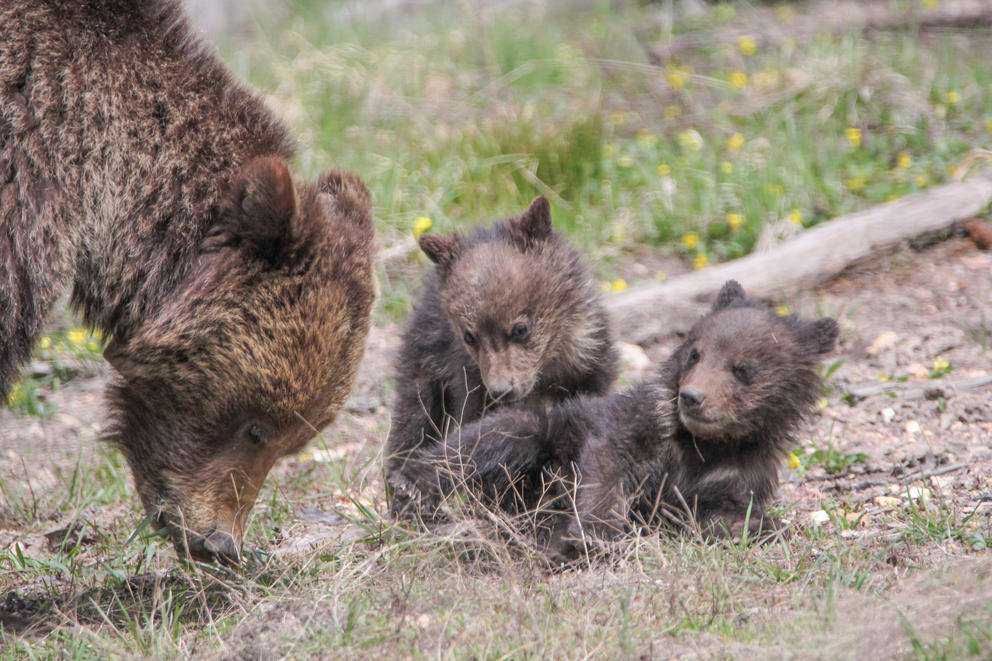
Grizzly bears near Roaring Mountain at Yellowstone National Park. (Courtesy of E. Johnston/National Park Service)
Grizzly bears will roam the North Cascades region for the first time in 27 years under a restoration process conducted by the National Park Service and U.S. Fish & Wildlife Service, the two agencies announced Thursday.
According to the agencies’ restoration plan, they will capture 25 grizzly bears from the Rocky Mountains or interior British Columbia and release them in the North Cascades over five to 10 years. The aim is for this initial population to grow to 200 bears in 60-100 years.
Agencies have not yet set a timeline to relocate grizzly bears to the North Cascades. The National Park Service will publish updates on its website.
Federal agencies say restoring a grizzly bear population would bring back ecological interactions crucial and beneficial to the region’s fish and wildlife habitat, including seed dispersal to replenish plant life and regulation of the prey population. The U.S. portion of the North Cascades region spans 9,800 square miles. About 85% of the region is under federal management.
However, not all welcomed the news. U.S. Rep. Dan Newhouse, R-Yakima, has proposed legislation to prevent the relocation, noting the potential impact on residents, livestock and wildlife.
“This administration is, once again, disregarding local public opinion and instead catering to the whims of coastal elites and the out-of-touch environmentalist lobby, which has been rushing to finalize this plan since its inception,” Newhouse said in a news release Thursday.
Grizzly bears inhabited the North Cascades for thousands of years, but the population has declined due to killing by humans. The species hasn’t been seen in the North Cascade since 1996. The species is currently classified as threatened in the lower 48 states.
The bears will be designated as a nonessential experimental population under the Endangered Species Act, which provides additional flexibility in restoring a species’ population.
The bears will have radio collars to provide wildlife managers with updates on their movement. Sightings of the bears are expected to be rare during the first 10 to 20 years of the restoration effort.
The restoration decision follows a two-year environmental impact evaluation process, which included more than 12,000 comments from the public.
WA Supreme Court upholds temporary ban on high-capacity magazines

Guns for rent at the Bellevue Indoor Gun Range on Monday, Aug. 22, 2022. (Amanda Snyder/Cascade PBS)
On Thursday morning, Washington Supreme Court Commissioner Michael Johnston issued a ruling upholding a temporary statewide ban on the sale of high-capacity magazines for guns.
Earlier this month, Cowlitz County Superior Court judge Gary Bashor ruled that the state Legislature’s 2022 law banning high-capacity magazines is unconstitutional. Commissioner Johnston issued an emergency stay immediately following Bashor’s ruling to temporarily keep the state ban in place.
Johnston’s April 25 ruling extends the temporary ban on the sale of high-capacity magazines while the case makes its way through the appeals process.
In September 2023, Washington State Attorney General Bob Ferguson sued Gator’s Custom Guns in Kelso. The suit alleged the store had offered more than 11,400 high-capacity magazines for sale since the state ban on magazines with more than 10 rounds went into effect in July 2022.
After Bashor issued his ruling overturning the ban on April 8, Ferguson successfully petitioned the state Supreme Court for an emergency stay, arguing the law was both constitutional and critical for addressing mass shootings. Limited-capacity magazines force shooters to stop and reload more frequently, giving people time to escape or disarm the shooter, he argued.
In the ruling today upholding that emergency stay, Johnston emphasized the use of high-capacity magazines in mass shootings. He wrote, “The State contends there is an unacceptable public safety risk if I do not impose a stay and the trade in [high-capacity magazines] resumes.”
The brief continues, “It is all but certain mass shootings will occur in Washington. This legislation will not necessarily prevent them from happening, but it will increase potential victims’ chances of survival. By declaring the statute unconstitutional and enjoining its enforcement, the superior court deprives Washington’s citizens of needed protection enacted by their elected representatives.”
Johnston also cited the rush to buy high-capacity magazines in the 90 or so minutes between Bashor’s ruling and Johnston’s issue of an emergency stay.
Today’s ruling states that Gator’s Guns boasted on social media that they sold high-capacity magazines to about 250 customers in that brief window on April 8.
King County was awarded a $6 million grant from the Washington State Department of Commerce to create more than 400 electric-vehicle charging ports throughout the county. King County Executive Dow Constantine announced the grant on Tuesday, and says this is part of the county’s mission to expand its zero-emission vehicles.
King County applied for this grant in a joint effort with 20 partners around the region – for example, community centers, multifamily housing, retail businesses – places where these charging stations will be installed. The charging grant was made possible through the state’s cap-and-invest program, Climate Commitment Act.
These charging ports will be available to the public in 55 locations, including nine King County charging sites, 13 multifamily residential buildings and 16 other locations like Metro bus bases.
Installation could begin in three months in areas that already have charging stations, and take longer for areas that do not, said Ross Freeman, King County Fleet Electrification and Electric Vehicle Infrastructure planner.
King County, along with other public agencies, have been moving toward lowering carbon emissions from vehicles. King County Metro Transit has a combination of diesel and hybrid vehicles, but they’re making the move to fully battery-operated buses, Freeman said. The county recently created a fully electric base for 120 zero-emission buses.
Freeman said about 10% of King County support vehicles are electric. These vehicles perform operation check-ups or service locations. About 5% of other vehicles are fully electric, but, Freeman said, a majority of county vehicles are hybrid.
Earlier this year, the state Department of Commerce announced that it will spend $85 million to expand access to electric vehicle charging throughout the state, including in Yakima, Vancouver and Spokane.
Tri-Cities wind turbine farm proposal halved for endangered hawks

In this June 3, 2011, file photo, wind turbines stand along the Columbia River Gorge near Goldendale, Wash. In recent years, huge solar and wind farms have sprouted on public desert land in the Western United States, buoyed by generous federal tax credits. (AP Photo/Rick Bowmer, File)
A Washington commission recommended approval Wednesday of a slimmed-down wind turbine project just south of the Tri-Cities.
The Washington Energy Facility Site Evaluation Council voted 5-2 to recommend that Gov. Jay Inslee approve the Horse Heaven Hills turbine project. The original project had faced criticism for threatening endangered ferruginous hawks and ruining views.
Inslee now has 60 days to make his decision. EFSEC is a committee of representatives from several Washington state agencies.
Scout Clean Energy of Boulder, Colorado, originally made plans for a maximum of 141 or 222 wind turbines – depending on approved height – along a 24-mile east/west stretch of the Horse Heaven Hills just south of Kennewick. However, the state council decided in February to implement two-mile buffer zones around 60 to 70 ferruginous hawk nests in that area and remove turbines along the north slopes of the hills.
The buffer zone cuts Scout Clean Energy’s number of turbines by roughly half, though the precise number won’t be available until the company maps out a new plan. The company said the changes trim the projected 1,150 megawatts of wind power to 236 megawatts.
Scout Clean Energy’s original proposal also included two 500-megawatt solar panel farms on the east and west sides of the 24-mile stretch. EFSEC ordered that the eastern solar farm be removed because of its proximity to sensitive Native cultural sites.
The wind farm has drawn strong opposition from numerous Tri-Citians because the original plan for the turbines would disrupt a currently pristine view of the hills from the urban area, and could disturb the ferruginous hawk nests.
"By partially approving the Horse Heaven wind and solar project, EFSEC is balancing the need for renewable, clean energy with potential impacts on tribal cultural resources, wildlife and surrounding communities,” said the council’s chairwoman Kathleen Drew at Wednesday’s meeting.
U.S. Supreme Court won’t hear challenge to WA Voting Rights Act
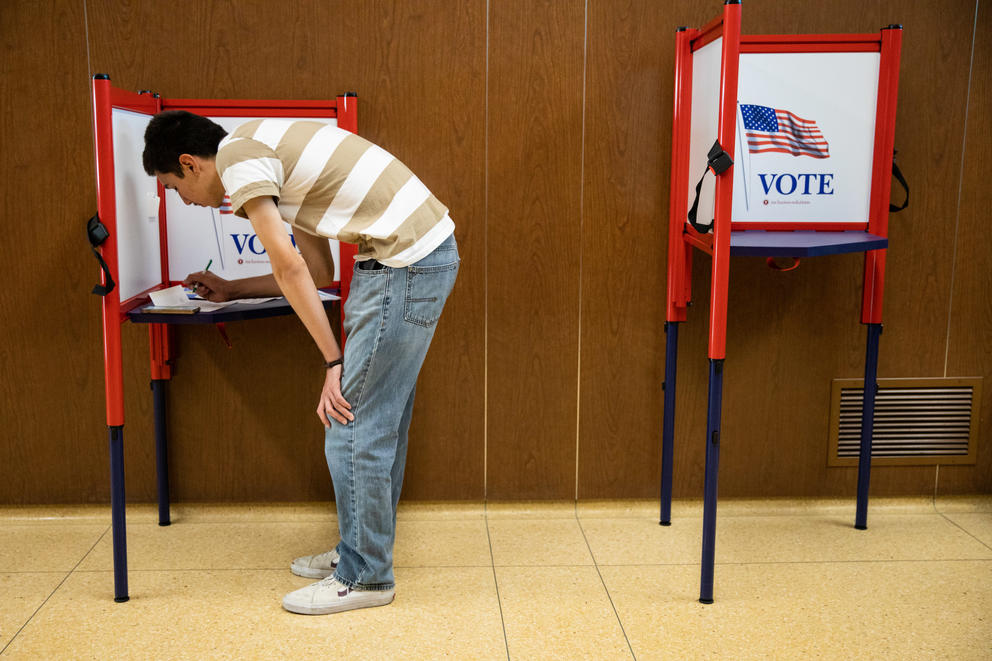
Jordan Chavez fills out a new ballot at the Yakima County Elections office on Thursday, July 28, 2022. This was Chavez’s first time voting. (Amanda Snyder/Cascade PBS)
The U.S. Supreme Court on Monday declined to review a state ruling that rejected a challenge to the Washington Voting Rights Act, upholding the constitutionality of the law.
The decision ends James Gimenez’ constitutional challenge of the state voting rights act. Gimenez, a Latino voter, claimed that three other Latino voters who sued Franklin County for suppressing their voting rights did not have standing because the WVRA provides protections for minority groups, and Latinos are the numerical majority in Franklin County.
Gimenez filed a motion to dismiss the case, then appealed to the Washington Supreme Court, arguing that the state’s voting rights act did not equally protect all races that end up in the minority.
The Washington Supreme Court ruled against Gimenez last year, stating that the three Latino voters could sue the county because the Washington Voting Rights Act indeed protects all Washington voters from discrimination on the basis of race, color and language minority.
The original case was concluded two years ago, after the three voters, along with the League of United Latin American Citizens, settled with Franklin County in May 2022. As part of that settlement, commissioners will now be elected in a district-based system for both the primary and general elections.
The state passed the Washington Voting Rights Act in 2018, with the intention of streamlining voting rights act enforcement and outlining steps to address remedies through resolution instead of through the courts.

The state Department of Ecology declared a drought emergency for most of the state Tuesday.
The department first noted the threat of drought after a dry start to the winter. While precipitation in the past three months contributed to an increase in Washington’s snowpack, there still isn’t enough water needed for farms, aquatic wildlife and people.
Snowpack is at 68% statewide, with several areas, including the Olympic Mountains, Lower Yakima and north Puget Sound region, having significantly lower numbers.
Drought is declared when there is less than 75% of normal water supply, and a risk of undue hardship. With anticipated warm and dry conditions this spring, Ecology said in a news release that it wanted to declare a drought to make assistance available before impacts become severe. The agency will have up to $4.5 million available for drought response grants for qualifying public entities to respond to the impact of current drought conditions. Declaring an emergency also allows Ecology to process emergency water-rights permits and transfers.
Ecology is working with other state agencies to coordinate the drought response. Drought conditions could adversely affect the state’s agriculture industry (still recovering from losses from several years of adverse weather conditions) and also adversely impact fish and other wildlife.
This drought emergency includes more of the state than the emergency from 2023, which was declared for watersheds in 12 counties. This time around, only a portion of the Puget Sound area, including the cities of Seattle, Everett and Tacoma, are not included in the emergency. Those cities have reservoir storage and water management strategies that make them resilient to drought, Ecology said in the news release.
A dozen Washington school districts were recognized with the first-ever Purple Star Awards earlier this month for their support of active-duty military families. The state Legislature approved the program last year to recognize school districts that demonstrated a commitment to addressing the needs of students in families serving in the military.
The school districts are
- Bremerton School District
- Central Kitsap School District
- Cheney School District
- Clover Park School District
- Medical Lake School District
- North Mason School District
- North Thurston Public Schools
- Oak Harbor Public Schools
- Peninsula School District
- Steilacoom Historical School District
- Sumner-Bonney Lake School District
- Yelm Community Schools
To receive the award, school districts need to provide tools and support for students of active-duty military families in their school through tending to the social and emotional barriers students face when their parents are deployed or when they relocate and transfer to a different school. It is also a requirement for the district to host a military recognition event to demonstrate a military-friendly culture or to publicize the district’s support for active-duty military families.
These school districts work with the Interstate Compact Council, which helps children of military personnel when moving from different schools. One example of this is giving their teachers training on how to better serve their students from active-duty military families.
Washington has 39,860 children of active-duty military and 19,411 children of National Guard members and reservists, according to the Defense Manpower Data Center.
The Office of the Superintendent of Public Instruction and the Washington Association of School Administrators jointly administer the designation, which will be in place for the districts for two years.
Help Washington State University name its new apple
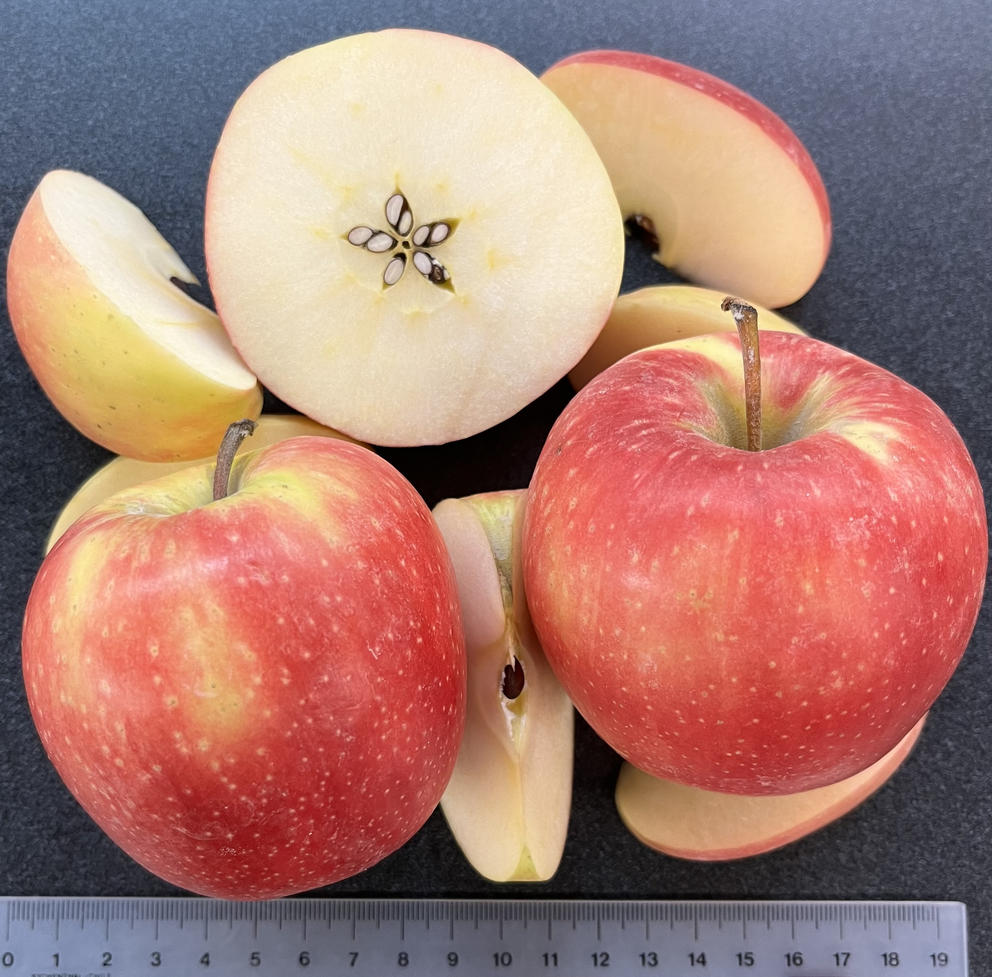
Washington State University recently launched a contest to name WA 64, an apple variety that is a hybrid of Honeycrisp and Cripps Pink. The variety, developed by WSU’s apple breeding program, is expected in grocery stores in 2029. (Photo courtesy of WSU)
Washington State University plans to launch its new apple variety in a few years, but is asking the public now for possible names. The university launched an online survey and contest seeking suggestions on what to name the apple currently known as WA 64. The deadline to enter is May 5.
It will be WSU’s second new apple launch in a decade, after the 2019 debut of Cosmic Crisp.
WA 64, in the works for more than 20 years, is a hybrid of Honeycrisp and Cripps Pink, a variety better known by its trademark name, Pink Lady. WSU is in the process of selecting a commercial partner who will manage the rollout of the apple to Washington growers and nurseries. Trees are expected to be widely available to growers by 2026, and the apple is expected to appear in grocery shows by 2029, according to a WSU news release.
Cosmic Crisp was also developed through WSU’s apple breeding program. Cosmic Crisp, a crossbreed of Enterprise and Honeycrisp grown exclusively in Washington, is among the top 10 best-selling apple varieties in the U.S. by sales and volume, according to WSU, citing Nielsen data.
WSU pursued further development of WA 64 because it showed good eating and storage quality. Developers describe WA 64 as crisper and juicier than Cripps Pink and slightly less crisp and juicy than Honeycrisp, providing sweetness and acidity that falls between the two varieties.
The contest is open to U.S. residents 18 and older. Besides suggesting a name for WA 64, participants will also answer several questions, including how they came up with their suggested name and about their fresh apple purchasing habits. The winner chosen will receive a prize package that includes a variety of WSU items, including a gift box of WA64s and Cougar Gold, the university’s famed canned cheese.
